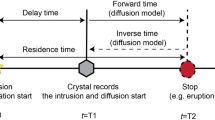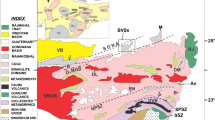Abstract
The role of melt movement is discussed with reference to the development of phase and cryptic magmatic layering. Differences in the evolution of unmoving and moving melt are controlled by the corresponding types of local equilibria: mosaic and volumetric, respectively. Unmoving melt crystallizes within its marginal gradient zone containing suspension of crystals, and this process gradually extends to the whole melt volume in the chamber. Mineral grains nucleate in the homogeneous melt ahead of the crystallization front. Each crystallization center is immediately surrounded by a locally equilibrated isolated diffusion cell, and hence, only complementary gravitational fractionation of the solid phase from a melt of unchanging composition can take place in unmoving melt. This is the reason for the absence of cryptic layering in the crystallization products. Phase layering is generated by the overlap of batch fractionation with the participation of phase convection, which disturbs the even character of the former, on the continuous process of melt equilibrium crystallization within isolated diffusion cells. Moving melt undergoes in-situ fractional crystallization within a narrow marginal gradient layer. Its composition and temperature systematically change in the course of its consolidation, and this results in the cryptic layering of the crystallization products. The phase layering is controlled by the crystallization sequence of phases on the liquidus at decreasing temperature and by the self-sustained oscillatory process of nucleation in the undercooled melt in the course of cotectic crystallization. It is demonstrated that the origin of layered rock series of the Moncha Tundra and Monchegorsk massifs and one of the world’s largest Stillwater Complex was formed by the crystallization of unmoving melt. Intrusive massifs in the Imandra gabbroid complex in the Monchegorsk district and the Pilgujarvi gabbro-wehrlite complex in the Pechenga district, Kola Peninsula, the Burakovka Massif in southern Karelia, and the Bushveld Complex in South Africa were formed with the participation of overall melt convection. The compositional variations of bodies filling fractures in the root zone of the Monchegorsk Pluton were controlled by the fractional crystallization of mantle melt at the walls of magma conduits during melt ascent to upper crustal levels and provide evidence of variations in the melt velocity.
Similar content being viewed by others
References
Amelin, Yu.V., Heaman, L.M., and Semenov, V.S., U-Pb Geochronology of Layered Mafic Intrusion in the Eastern Baltic Shield: Implications for the Timing and Duration of Paleoproterozoic Continental Rifting, Precambrian Res., 1995, vol. 75, pp. 31–46.
Ariskin, A.A. and Barmina, G.S., Modelirovanie fazovykh ravnovesii pri kristallizatsii bazal’tovykh magm (Simulation of Phase Equilibria during Crystallization of Basaltic Magmas), Moscow: MAIK, 2000.
Bowen, N.L. and Schairer, J.F., System MgO-FeO-SiO2, Am. J. Sci., 1935, vol. 29, pp. 151–217.
Bowes, D.R., Skinner, W.R., and Skinner, D.R., Petrochemistry of the Stillwater Igneous Complex, Montana, Trans. Geol. Soc. S. Afr., 1973, vol. 76, pp. 153–163.
Campbell, I.H., Fluid Dynamic Processes in Basaltic Magma Chambers, in Layered Intrusions, Cawthorn R.G., Ed., Amsterdam: Elsevier, 1996, pp. 45–78.
Campbell, I.H., Some Problems with the Cumulus Theory, Lithos, 1978, vol. 11, no. 4, pp. 311–323.
Chalmers, B., Principles of Solidification, London: Wileys, 1964.
Chashchin, V.V., Bayanova, T.B., and Levkovich, N.V., Volcanoplutonic Association of the Early-Stage Evolution of the Imandra-Varzuga Rift Zone, Kola Peninsula, Russia: Geological, Petrogeochemical, and Isotope-Geochronological Data, Petrologiya, 2008, vol. 16, no. 3, pp. 296–313 [Petrology (Engl. Transl.), vol. 16, no. 3, pp. 279–298].
Chistyakov, A.V., Extended Abstract of Cand. Diss. in Geology and Mineralogy, Moscow: IGEM RAN, 2004.
Eales, H.V. and Cawthorn, R.G., The Bushveld Complex, in Layered Intrusions, Cawthorn R.G., Ed., Amsterdam: Elsevier, 1996, pp. 181–229.
Fedotov, Zh.A., Dynamic Model of Magmatic Evolution, in Metamorfizm, kosmicheskie, eksperimental’nye i obshchie problemy petrologii. Materialy X Vserossiiskogo petrograficheskogo soveshchaniya “Petrografiya XXI veka” (Metamorphism, Cosmic, Experimental, and General Problems of Petrology. Proceedings of 10th All-Russian Petrographic Conference on “Petrography of 21st Century”), Apatity: Kol’sk. Nauchn. Ts. Ross. Akad. Nauk, 2005, vol. 4, pp. 237–239.
Fenner, C.N., The Crystallization of Basalts, Am. J. Sci., 1929, vol. 18, pp. 225–253.
Frenkel’, M.Ya., Teplovaya i khimicheskaya dinamika differentsiatsii bazitovykh magm (Thermal and Chemical Dynamics of Differentiation of Basaltic Magmas), Moscow: Nauka, 1995.
Galimzyanova, R.M., Mitrofanov, F.P., Bayanova, T.B., et al., Origin and U-Pb Age of Granophyres of the Imandra Differentiated Intrusion, Kola Region, Dokl. Akad. Nauk, 1998, vol. 363, no. 6, pp. 805–808 [Dokl. Earth Sci. (Engl. Transl.), vol. 363, no. 6, pp. 1301–1303].
Hall, A.L., The Bushveld Igneous Complex of the Central Transvaal, Mem. Geol. Surv. Union S. Afr., 1932, no. 28, p. 554.
Irvine, T.N. and Baragar, W.R., A Guide to the Chemical Classification of the Common Volcanic Rocks, Can. J. Earth Sci., 1971, vol. 8, pp. 523–548.
Jensen, L.S., A New Cation Plot for Classifying Subalkalic Volcanic Rocks, Ont. Dep. Min. Misc. Pap, 1976, vol. 66, pp. 1–22.
Korzhinskii, D.S., Teoreticheskie osnovy analiza paragenezisov mineralov (Theoretical Principles of Analysis of Mineral Assemblages), Moscow: Nauka, 1973.
Kozlov, E.K., Estestvennye ryady porod nikelenosnykh intruzii i ikh metallogeniya (Natural Rock Series of the Nickel-Bearing Intrusions and Their Metallogeny), Leningrad: Nauka, 1973.
Langmuir, C.H., Geochemical Consequences of in Situ Crystallization, Nature, 1989, vol. 340, no. 6230, pp. 199–205.
Lavrov, M.M., Golubev, A.I., and Trofimov, N.N., Geochemistry and Ore Potential of the Burakovka Layered Massif, in Geologiya i poleznye iskopaemye Karelii (Geochemistry and Ore Potential of the Burakovka Layered Massif), Petrozavodsk: Karel’sk. Nauchn. Ts. Ross. Akad. Nauk, 2004, issue 7, pp. 75–91.
McBirney, A.R., The Skaergaard Intrusion in Layered Intrusions, Cawthorn R.G, Ed., Amsterdam: Elsevier, 1996, pp. 147–180.
Mitrofanov, F.P., Fedotov, Zh.A., Zhangurov, A.A., et al., Prospects of Platinum Potential of the Imandra Layered Intrusion, in Platina Rossii (Platinum of Russia), Moscow: Geoinformmark, 1995, vol. 2, book 2, pp. 26–42.
O’Hara, M.J. and Fry, N., Geochemical Effects of Small Packet Crystallization in Large Magma Chamber—Further Resolution of the Highly Compatible Element Paradox, J. Petrol., 1996, vol. 37, no. 4, pp. 891–925.
Rollinson, H.R., Using Geochemical Data: Evaluation, Presentation, Interpretation, Singapore: Longman, 1993.
Ryabchikov, I.D., Processes of Mantle Magma Formation, in Magmaticheskie gornye porody. Evolyutsiya magmatizma v istorii Zemli (Magmatic Rocks. Evolution of Magmatism in the Earth’s History), Moscow: Nauka, 1987, pp. 349–372.
Sharkov, E.V., Petrologiya rassloennykh intruzii (Petrology of the Layered Intrusions), Leningrad: Nauka, 1980.
Smol’kin, V.F., Fedotov, Zh.A., Neradovskii, Yu.N., et al. Rassloennye intruzii Monchegorskogo rudnogo uzla (Layered Intrusions of the Monchegorsk Group of Mineral Deposits), Apatity: Kol’sk. Nauchn. Ts. Ross. Akad. Nauk, 2004.
Smol’kin, V.F., Petrologiya Pil’guyarvinskogo rudonosnogo intruziva (Pechenga) (Petrology of the Pilgujarvi ore-bearing intrusion (Pechenga)), Available from VINITI, 1977, Apatity, no. 2114-77.
Wager, L. and Brown, G., Layered Igneous Rocks Edinburgh: Oliver and Boyd, 1968.
Author information
Authors and Affiliations
Corresponding author
Additional information
Original Russian Text © Zh.A. Fedotov, 2011, published in Petrologiya, 2011, Vol. 19, No. 2, pp. 205–224.
Rights and permissions
About this article
Cite this article
Fedotov, Z.A. Role of general melt convection in the development of cryptic layering of intrusive complexes at cratons. Petrology 19, 198–216 (2011). https://doi.org/10.1134/S0869591111020056
Received:
Accepted:
Published:
Issue Date:
DOI: https://doi.org/10.1134/S0869591111020056




